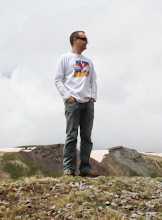Today is a day for remembrance, as at 11am we all stop for a couple of minutes and remember the war dead, particularly from World Wars I and II. It's also a day for working at home due to the Zepler building still being sealed off (although rumours are rife that we may be allowed some kind of access at some point next week). And it's a day for football, as I play my first five-a-side game of the Veteran's League season, hoping to pull 'ECS Footie' somewhere above mid-table obscurity this season.
And less important than all is a sad piece of news reported in The Times last Saturday, which I only just saw this morning. It seems that some killjoy Canadian scientists have further destroyed the notion that life in Devon can be occasionally interesting by announcing the results of their study into the physics of cow tipping. Not only would it take between two and five people to exert the force needed to tip your average moo-moo over, but they also state that when cows do the sleeping-standing-up thing, they're actually only dozing and would be easily woken. Therefore, you'd need a well-organised team of very quick-working cow-tippers to have any hope of success, and since this particular sport is the exclusive preserve of those leaving country pubs at chucking out time, there's little hope of them being well-coordinated enough to be able to perform such a task.
Now, this is all well and good, except for the fact that I've seen it first-hand. Growing up in rural Devon with a window that overlooked gently rolling farmland on the southern slopes of Dartmoor, you don't see much happening at any time of day, let alone after dark. But sometimes, just sometimes, you'd look out around 11.30 and see a couple of torches flashing around in a field over on the other side of the valley. Fascinated, I would continue to watch while the people - usually around six or seven in number - would walk unafraid towards some cows with the clear idea of tipping. Normally (actually, the vast majority of times) the cows would run away, thereby showing that they were not asleep in the first place, or perhaps were dozing as the Canadian study suggests. But on one occasion it happened: a cow, seemingly standing up, did not move as two tippers closed in. They got close, reached out their hands and pushed hard, while their companions shone their torches on the scene, lighting it up for anyone to see who happened to be looking. And yes, the cow did go over: not in the hilarious Del Boy fashion most people assume, it just kind of stumbled over, legs wobbling as it woke up and tried to right itself. The movement of the torchlight suggested laughter from the companions as the cow got back to its feet and ran off up the hill away from its assailants. The tippers then returned back in the direction of the main road and that was that.
So that's my cow-tipping story. Deeply unexciting, and probably backs up the Canadian study more than anything else, except it clearly shows one thing: cow-tipping is a sufficiently well-known 'rural myth' that it will be (and is) attempted by someone, somewhere on at least a semi-regular basis. And yes, it does work, at least sometimes: this letter to Canada's National Post offers an alternative view of the physics of it all. The problem, of course, is that the original scientists did their work based on a particular model of physics and theoretical analysis: they didn't actually go out and try it empirically. Would have saved them a lot of time if they had, but hey, that's the nature of scientific research.
Which leads to the secondary question: who on earth funded their study in the first place? And were they pleased with the results?
Subscribe to:
Post Comments (Atom)

No comments:
Post a Comment